Biblical Studies Assignment PDF
VerifiedAdded on 2021/06/14
|12
|3230
|123
AI Summary
Contribute Materials
Your contribution can guide someone’s learning journey. Share your
documents today.
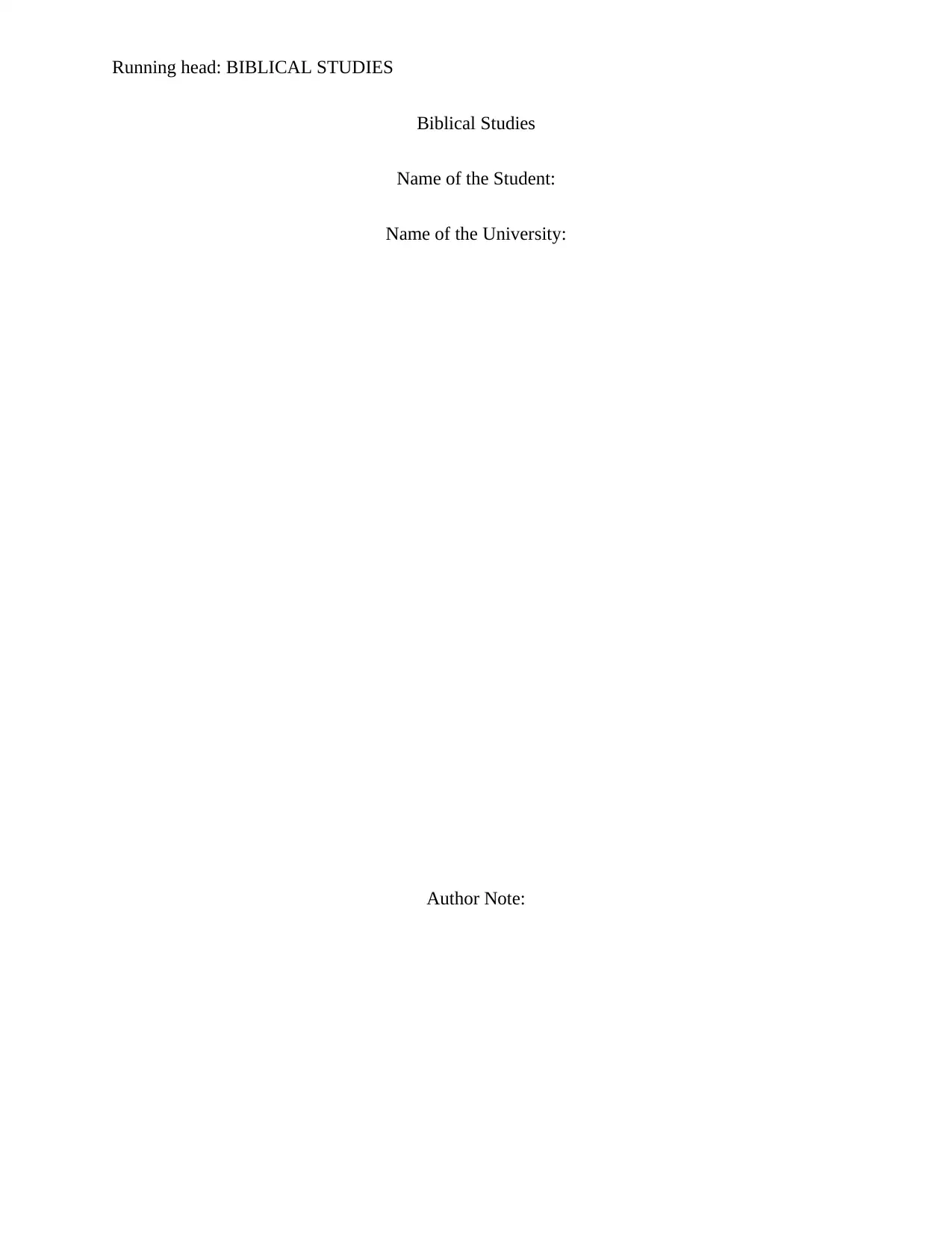
Running head: BIBLICAL STUDIES
Biblical Studies
Name of the Student:
Name of the University:
Author Note:
Biblical Studies
Name of the Student:
Name of the University:
Author Note:
Secure Best Marks with AI Grader
Need help grading? Try our AI Grader for instant feedback on your assignments.
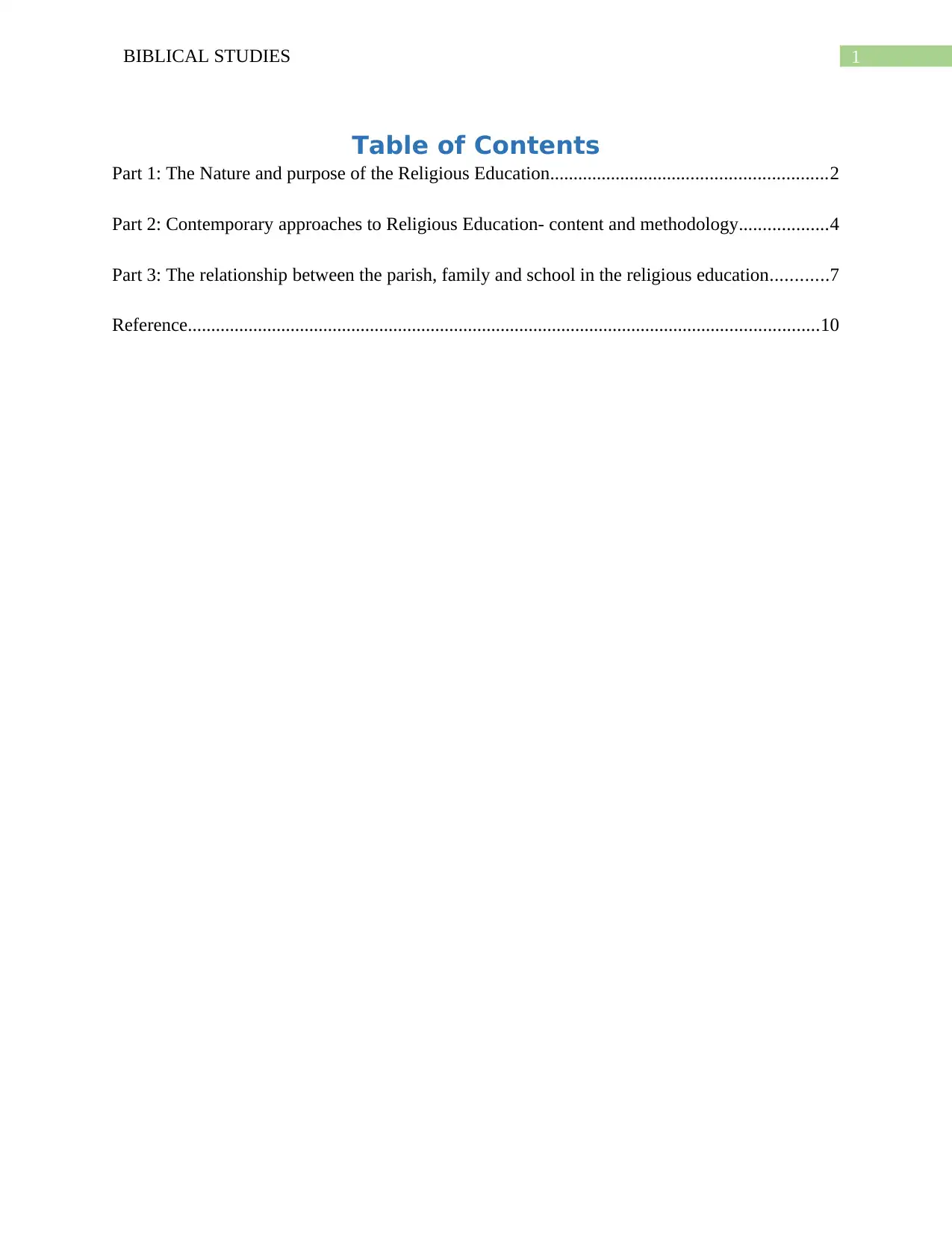
1BIBLICAL STUDIES
Table of Contents
Part 1: The Nature and purpose of the Religious Education...........................................................2
Part 2: Contemporary approaches to Religious Education- content and methodology...................4
Part 3: The relationship between the parish, family and school in the religious education............7
Reference.......................................................................................................................................10
Table of Contents
Part 1: The Nature and purpose of the Religious Education...........................................................2
Part 2: Contemporary approaches to Religious Education- content and methodology...................4
Part 3: The relationship between the parish, family and school in the religious education............7
Reference.......................................................................................................................................10
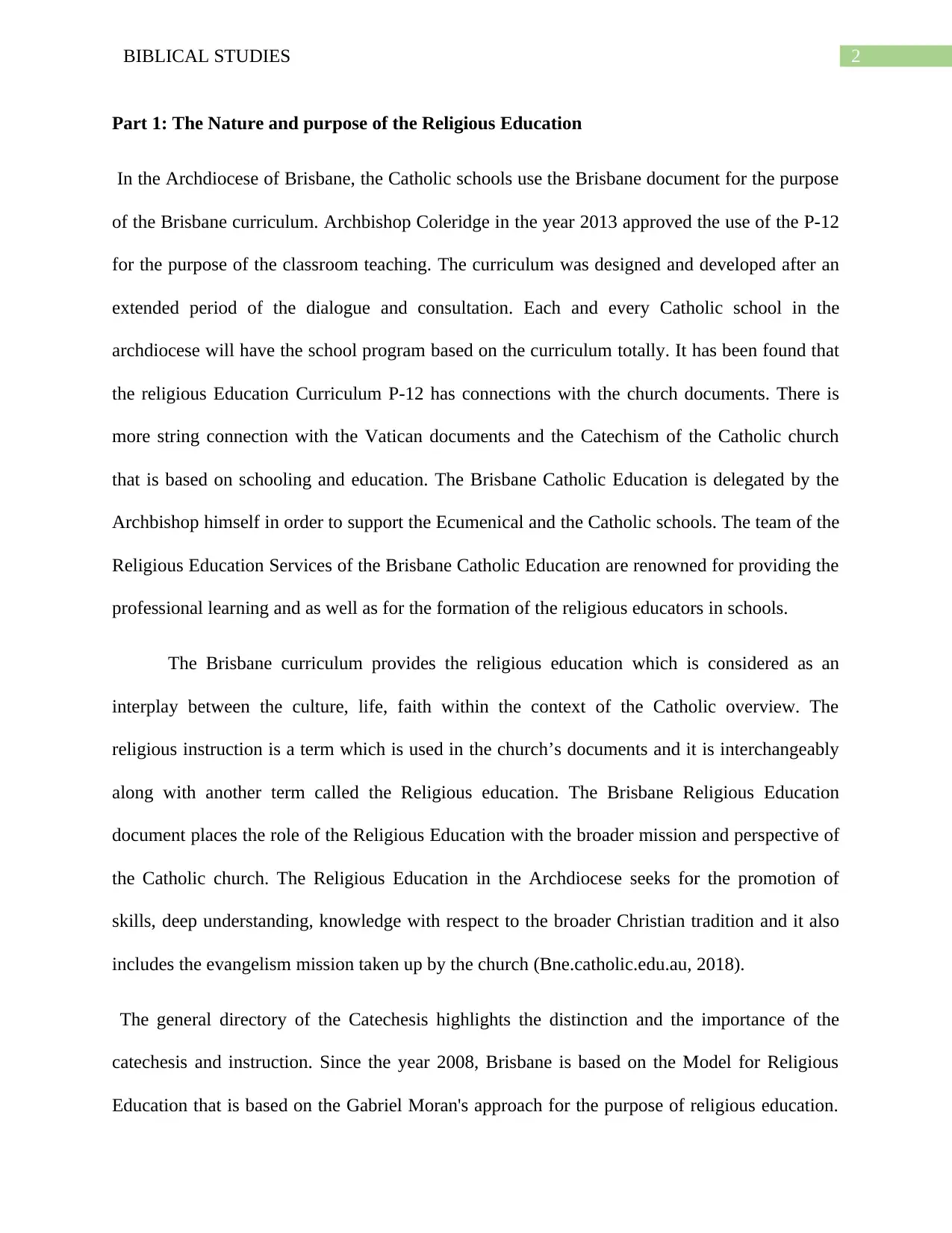
2BIBLICAL STUDIES
Part 1: The Nature and purpose of the Religious Education
In the Archdiocese of Brisbane, the Catholic schools use the Brisbane document for the purpose
of the Brisbane curriculum. Archbishop Coleridge in the year 2013 approved the use of the P-12
for the purpose of the classroom teaching. The curriculum was designed and developed after an
extended period of the dialogue and consultation. Each and every Catholic school in the
archdiocese will have the school program based on the curriculum totally. It has been found that
the religious Education Curriculum P-12 has connections with the church documents. There is
more string connection with the Vatican documents and the Catechism of the Catholic church
that is based on schooling and education. The Brisbane Catholic Education is delegated by the
Archbishop himself in order to support the Ecumenical and the Catholic schools. The team of the
Religious Education Services of the Brisbane Catholic Education are renowned for providing the
professional learning and as well as for the formation of the religious educators in schools.
The Brisbane curriculum provides the religious education which is considered as an
interplay between the culture, life, faith within the context of the Catholic overview. The
religious instruction is a term which is used in the church’s documents and it is interchangeably
along with another term called the Religious education. The Brisbane Religious Education
document places the role of the Religious Education with the broader mission and perspective of
the Catholic church. The Religious Education in the Archdiocese seeks for the promotion of
skills, deep understanding, knowledge with respect to the broader Christian tradition and it also
includes the evangelism mission taken up by the church (Bne.catholic.edu.au, 2018).
The general directory of the Catechesis highlights the distinction and the importance of the
catechesis and instruction. Since the year 2008, Brisbane is based on the Model for Religious
Education that is based on the Gabriel Moran's approach for the purpose of religious education.
Part 1: The Nature and purpose of the Religious Education
In the Archdiocese of Brisbane, the Catholic schools use the Brisbane document for the purpose
of the Brisbane curriculum. Archbishop Coleridge in the year 2013 approved the use of the P-12
for the purpose of the classroom teaching. The curriculum was designed and developed after an
extended period of the dialogue and consultation. Each and every Catholic school in the
archdiocese will have the school program based on the curriculum totally. It has been found that
the religious Education Curriculum P-12 has connections with the church documents. There is
more string connection with the Vatican documents and the Catechism of the Catholic church
that is based on schooling and education. The Brisbane Catholic Education is delegated by the
Archbishop himself in order to support the Ecumenical and the Catholic schools. The team of the
Religious Education Services of the Brisbane Catholic Education are renowned for providing the
professional learning and as well as for the formation of the religious educators in schools.
The Brisbane curriculum provides the religious education which is considered as an
interplay between the culture, life, faith within the context of the Catholic overview. The
religious instruction is a term which is used in the church’s documents and it is interchangeably
along with another term called the Religious education. The Brisbane Religious Education
document places the role of the Religious Education with the broader mission and perspective of
the Catholic church. The Religious Education in the Archdiocese seeks for the promotion of
skills, deep understanding, knowledge with respect to the broader Christian tradition and it also
includes the evangelism mission taken up by the church (Bne.catholic.edu.au, 2018).
The general directory of the Catechesis highlights the distinction and the importance of the
catechesis and instruction. Since the year 2008, Brisbane is based on the Model for Religious
Education that is based on the Gabriel Moran's approach for the purpose of religious education.
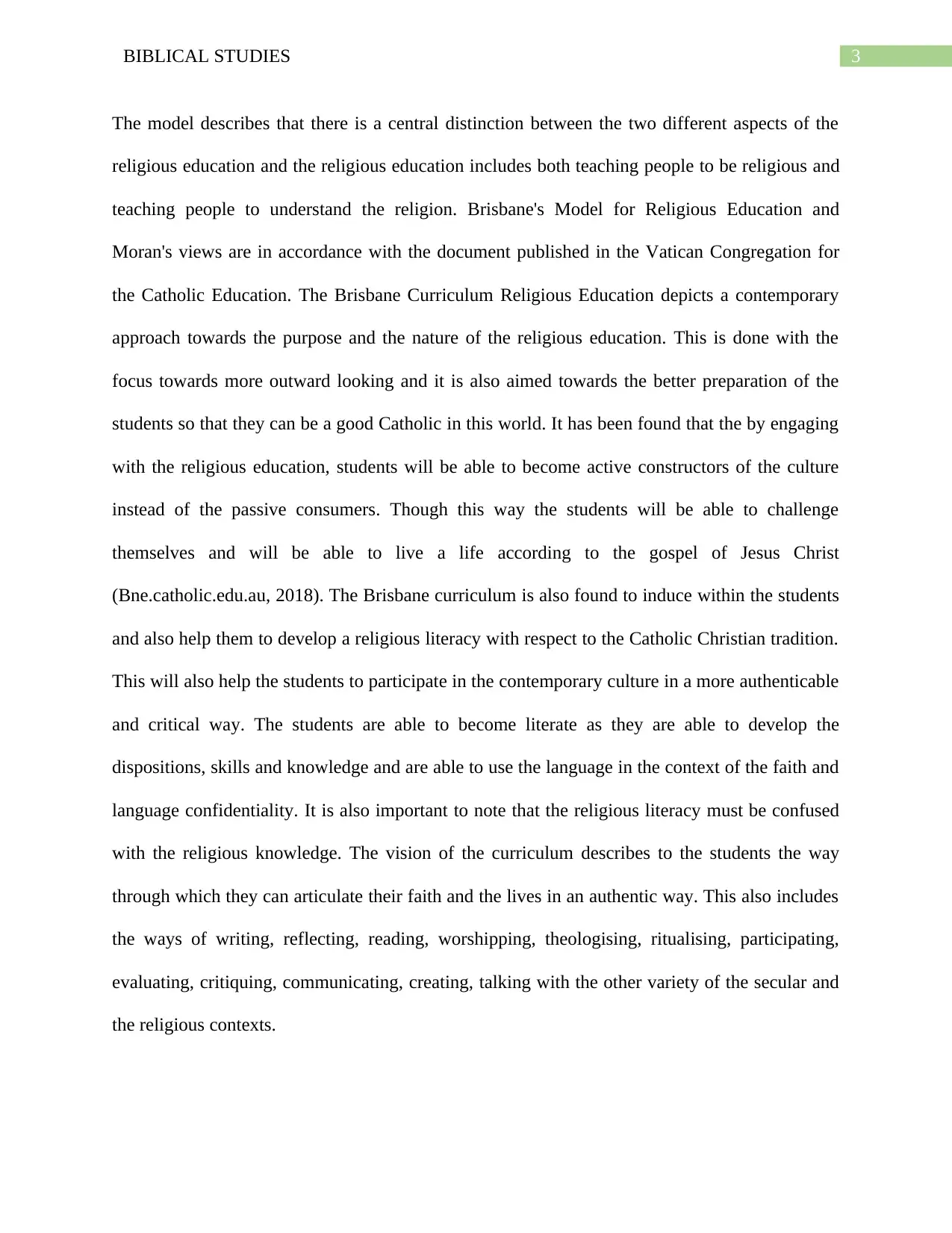
3BIBLICAL STUDIES
The model describes that there is a central distinction between the two different aspects of the
religious education and the religious education includes both teaching people to be religious and
teaching people to understand the religion. Brisbane's Model for Religious Education and
Moran's views are in accordance with the document published in the Vatican Congregation for
the Catholic Education. The Brisbane Curriculum Religious Education depicts a contemporary
approach towards the purpose and the nature of the religious education. This is done with the
focus towards more outward looking and it is also aimed towards the better preparation of the
students so that they can be a good Catholic in this world. It has been found that the by engaging
with the religious education, students will be able to become active constructors of the culture
instead of the passive consumers. Though this way the students will be able to challenge
themselves and will be able to live a life according to the gospel of Jesus Christ
(Bne.catholic.edu.au, 2018). The Brisbane curriculum is also found to induce within the students
and also help them to develop a religious literacy with respect to the Catholic Christian tradition.
This will also help the students to participate in the contemporary culture in a more authenticable
and critical way. The students are able to become literate as they are able to develop the
dispositions, skills and knowledge and are able to use the language in the context of the faith and
language confidentiality. It is also important to note that the religious literacy must be confused
with the religious knowledge. The vision of the curriculum describes to the students the way
through which they can articulate their faith and the lives in an authentic way. This also includes
the ways of writing, reflecting, reading, worshipping, theologising, ritualising, participating,
evaluating, critiquing, communicating, creating, talking with the other variety of the secular and
the religious contexts.
The model describes that there is a central distinction between the two different aspects of the
religious education and the religious education includes both teaching people to be religious and
teaching people to understand the religion. Brisbane's Model for Religious Education and
Moran's views are in accordance with the document published in the Vatican Congregation for
the Catholic Education. The Brisbane Curriculum Religious Education depicts a contemporary
approach towards the purpose and the nature of the religious education. This is done with the
focus towards more outward looking and it is also aimed towards the better preparation of the
students so that they can be a good Catholic in this world. It has been found that the by engaging
with the religious education, students will be able to become active constructors of the culture
instead of the passive consumers. Though this way the students will be able to challenge
themselves and will be able to live a life according to the gospel of Jesus Christ
(Bne.catholic.edu.au, 2018). The Brisbane curriculum is also found to induce within the students
and also help them to develop a religious literacy with respect to the Catholic Christian tradition.
This will also help the students to participate in the contemporary culture in a more authenticable
and critical way. The students are able to become literate as they are able to develop the
dispositions, skills and knowledge and are able to use the language in the context of the faith and
language confidentiality. It is also important to note that the religious literacy must be confused
with the religious knowledge. The vision of the curriculum describes to the students the way
through which they can articulate their faith and the lives in an authentic way. This also includes
the ways of writing, reflecting, reading, worshipping, theologising, ritualising, participating,
evaluating, critiquing, communicating, creating, talking with the other variety of the secular and
the religious contexts.
Secure Best Marks with AI Grader
Need help grading? Try our AI Grader for instant feedback on your assignments.

4BIBLICAL STUDIES
The Brisbane Religious education thrives to provide the students with the introduction and also
helps in understanding the established understanding that is in accordance with the Catholic
Christian Tradition. The Brisbane curriculum is also characterised by the reconceptualise
approach that operates through the education framework instead of operating through the shared
Christian praxis or the framework of catechesis. The Brisbane religious education is based on the
work of the Gabriel Moran that is considered as a major proponent of the reconceptualist
approach. Within the reconceptualist approach, the curriculum avoids the usage of the
assumptions and the presumptive language (Bne.catholic.edu.au, 2018).
Part 2: Contemporary approaches to Religious Education- content and methodology
Reconceptualist approach- Religious education curriculum documents are commonly
used for the purpose of imparting the teaching related to the Catholic tradition. In a
reconceptualist approach, the teachers do not initiate with the assumptions about the faith of the
student also the teachers also avoid the usage of the presumptive language. In a religion
classroom, the teachers prefer the usage of language that is educational and invitational for the
purpose of better engagement with the students. Thus, it is seen that the students that identify
themselves as Catholics are affirmed through this approach (Rec.bne.catholic.edu.au, 2018).
A reconceptualist approach includes the exploration of a person’s own religious life with respect
to the those that share the religious life and those who do not. This education approach lays
emphasis on critical appreciation of one's own religion and at the same time have an empathy
towards the other people that practice a different religion. It is important to note that the
reconceptualist classroom is a not just a place where knowledge and facts are transferred, nor the
classroom is a place of a values-driven philosophy of religion. A reconceptualist approach to
The Brisbane Religious education thrives to provide the students with the introduction and also
helps in understanding the established understanding that is in accordance with the Catholic
Christian Tradition. The Brisbane curriculum is also characterised by the reconceptualise
approach that operates through the education framework instead of operating through the shared
Christian praxis or the framework of catechesis. The Brisbane religious education is based on the
work of the Gabriel Moran that is considered as a major proponent of the reconceptualist
approach. Within the reconceptualist approach, the curriculum avoids the usage of the
assumptions and the presumptive language (Bne.catholic.edu.au, 2018).
Part 2: Contemporary approaches to Religious Education- content and methodology
Reconceptualist approach- Religious education curriculum documents are commonly
used for the purpose of imparting the teaching related to the Catholic tradition. In a
reconceptualist approach, the teachers do not initiate with the assumptions about the faith of the
student also the teachers also avoid the usage of the presumptive language. In a religion
classroom, the teachers prefer the usage of language that is educational and invitational for the
purpose of better engagement with the students. Thus, it is seen that the students that identify
themselves as Catholics are affirmed through this approach (Rec.bne.catholic.edu.au, 2018).
A reconceptualist approach includes the exploration of a person’s own religious life with respect
to the those that share the religious life and those who do not. This education approach lays
emphasis on critical appreciation of one's own religion and at the same time have an empathy
towards the other people that practice a different religion. It is important to note that the
reconceptualist classroom is a not just a place where knowledge and facts are transferred, nor the
classroom is a place of a values-driven philosophy of religion. A reconceptualist approach to
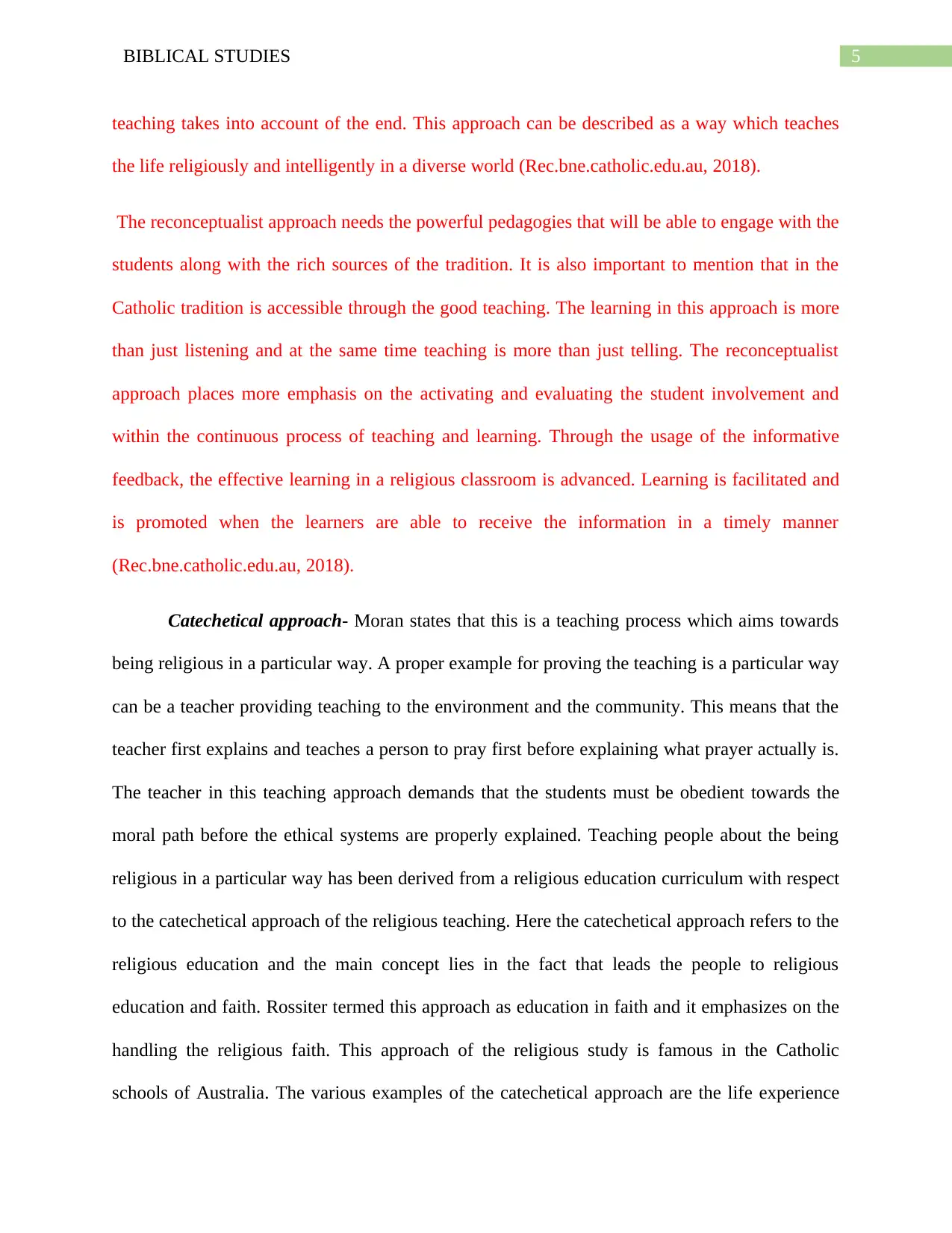
5BIBLICAL STUDIES
teaching takes into account of the end. This approach can be described as a way which teaches
the life religiously and intelligently in a diverse world (Rec.bne.catholic.edu.au, 2018).
The reconceptualist approach needs the powerful pedagogies that will be able to engage with the
students along with the rich sources of the tradition. It is also important to mention that in the
Catholic tradition is accessible through the good teaching. The learning in this approach is more
than just listening and at the same time teaching is more than just telling. The reconceptualist
approach places more emphasis on the activating and evaluating the student involvement and
within the continuous process of teaching and learning. Through the usage of the informative
feedback, the effective learning in a religious classroom is advanced. Learning is facilitated and
is promoted when the learners are able to receive the information in a timely manner
(Rec.bne.catholic.edu.au, 2018).
Catechetical approach- Moran states that this is a teaching process which aims towards
being religious in a particular way. A proper example for proving the teaching is a particular way
can be a teacher providing teaching to the environment and the community. This means that the
teacher first explains and teaches a person to pray first before explaining what prayer actually is.
The teacher in this teaching approach demands that the students must be obedient towards the
moral path before the ethical systems are properly explained. Teaching people about the being
religious in a particular way has been derived from a religious education curriculum with respect
to the catechetical approach of the religious teaching. Here the catechetical approach refers to the
religious education and the main concept lies in the fact that leads the people to religious
education and faith. Rossiter termed this approach as education in faith and it emphasizes on the
handling the religious faith. This approach of the religious study is famous in the Catholic
schools of Australia. The various examples of the catechetical approach are the life experience
teaching takes into account of the end. This approach can be described as a way which teaches
the life religiously and intelligently in a diverse world (Rec.bne.catholic.edu.au, 2018).
The reconceptualist approach needs the powerful pedagogies that will be able to engage with the
students along with the rich sources of the tradition. It is also important to mention that in the
Catholic tradition is accessible through the good teaching. The learning in this approach is more
than just listening and at the same time teaching is more than just telling. The reconceptualist
approach places more emphasis on the activating and evaluating the student involvement and
within the continuous process of teaching and learning. Through the usage of the informative
feedback, the effective learning in a religious classroom is advanced. Learning is facilitated and
is promoted when the learners are able to receive the information in a timely manner
(Rec.bne.catholic.edu.au, 2018).
Catechetical approach- Moran states that this is a teaching process which aims towards
being religious in a particular way. A proper example for proving the teaching is a particular way
can be a teacher providing teaching to the environment and the community. This means that the
teacher first explains and teaches a person to pray first before explaining what prayer actually is.
The teacher in this teaching approach demands that the students must be obedient towards the
moral path before the ethical systems are properly explained. Teaching people about the being
religious in a particular way has been derived from a religious education curriculum with respect
to the catechetical approach of the religious teaching. Here the catechetical approach refers to the
religious education and the main concept lies in the fact that leads the people to religious
education and faith. Rossiter termed this approach as education in faith and it emphasizes on the
handling the religious faith. This approach of the religious study is famous in the Catholic
schools of Australia. The various examples of the catechetical approach are the life experience

6BIBLICAL STUDIES
approach, kerygmatic approach, dogmatic approach (Franchi, 2013). The dogmatic approach is
also called the catechism, magisterial and traditional approaches of the religious education in
Australia. This approach explicitly focuses on the catechism and the teaching method lacks the
direct teaching from bible. Through the process of memorisation, the religious teaching is
presented superficially and it lacks the room for critical engagement and personal interpretation.
This teaching approach relies basically on teaching Catholic and not Christianity. Thus, this sort
of teaching does not fit into the modern world schools that have variety of culture in their
classrooms (Rymarz, 2013). The kerygmatic approach of the religious teaching came in to light
due to the Kerygmatic movements that took place in the Catholic Church. The movement
received an improved force or a push due to the renewed force in the scriptural and liturgical
catechesis of the early church. Due to the growing dissatisfaction with the dogmatic approach.
The kerygmatic approach stresses on the growing dissatisfaction with the dogmatic approach and
it emphasizes on the good news of the Christian message and narrows down the doctrinal
approach of the approach of the catechisms (Pollefeyt & Bouwens, 2014).
The Educational approach- in the year 1970, the theorists understood the fact that the
main aim of the religious education with the context of schools is far more different from the rest
of the programs that are taught in the Catholic schools. Gerard Rummery, Rossiter Graham are
the two main theorists that made the significant amount of contributions in the field of the
educational approach in Australia. Like the other catechesis, Gerard Rummery conceptualised
the religious education in the Australian schools. Graham Rossiter argued that the teachers need
to have the clear idea about the religious education and the nature of the catechesis and also the
context within which it will take place. Rossiter believed that the teacher has the realisation that
both the teachings must place within the separate contexts and the teachers will develop the
approach, kerygmatic approach, dogmatic approach (Franchi, 2013). The dogmatic approach is
also called the catechism, magisterial and traditional approaches of the religious education in
Australia. This approach explicitly focuses on the catechism and the teaching method lacks the
direct teaching from bible. Through the process of memorisation, the religious teaching is
presented superficially and it lacks the room for critical engagement and personal interpretation.
This teaching approach relies basically on teaching Catholic and not Christianity. Thus, this sort
of teaching does not fit into the modern world schools that have variety of culture in their
classrooms (Rymarz, 2013). The kerygmatic approach of the religious teaching came in to light
due to the Kerygmatic movements that took place in the Catholic Church. The movement
received an improved force or a push due to the renewed force in the scriptural and liturgical
catechesis of the early church. Due to the growing dissatisfaction with the dogmatic approach.
The kerygmatic approach stresses on the growing dissatisfaction with the dogmatic approach and
it emphasizes on the good news of the Christian message and narrows down the doctrinal
approach of the approach of the catechisms (Pollefeyt & Bouwens, 2014).
The Educational approach- in the year 1970, the theorists understood the fact that the
main aim of the religious education with the context of schools is far more different from the rest
of the programs that are taught in the Catholic schools. Gerard Rummery, Rossiter Graham are
the two main theorists that made the significant amount of contributions in the field of the
educational approach in Australia. Like the other catechesis, Gerard Rummery conceptualised
the religious education in the Australian schools. Graham Rossiter argued that the teachers need
to have the clear idea about the religious education and the nature of the catechesis and also the
context within which it will take place. Rossiter believed that the teacher has the realisation that
both the teachings must place within the separate contexts and the teachers will develop the
Paraphrase This Document
Need a fresh take? Get an instant paraphrase of this document with our AI Paraphraser
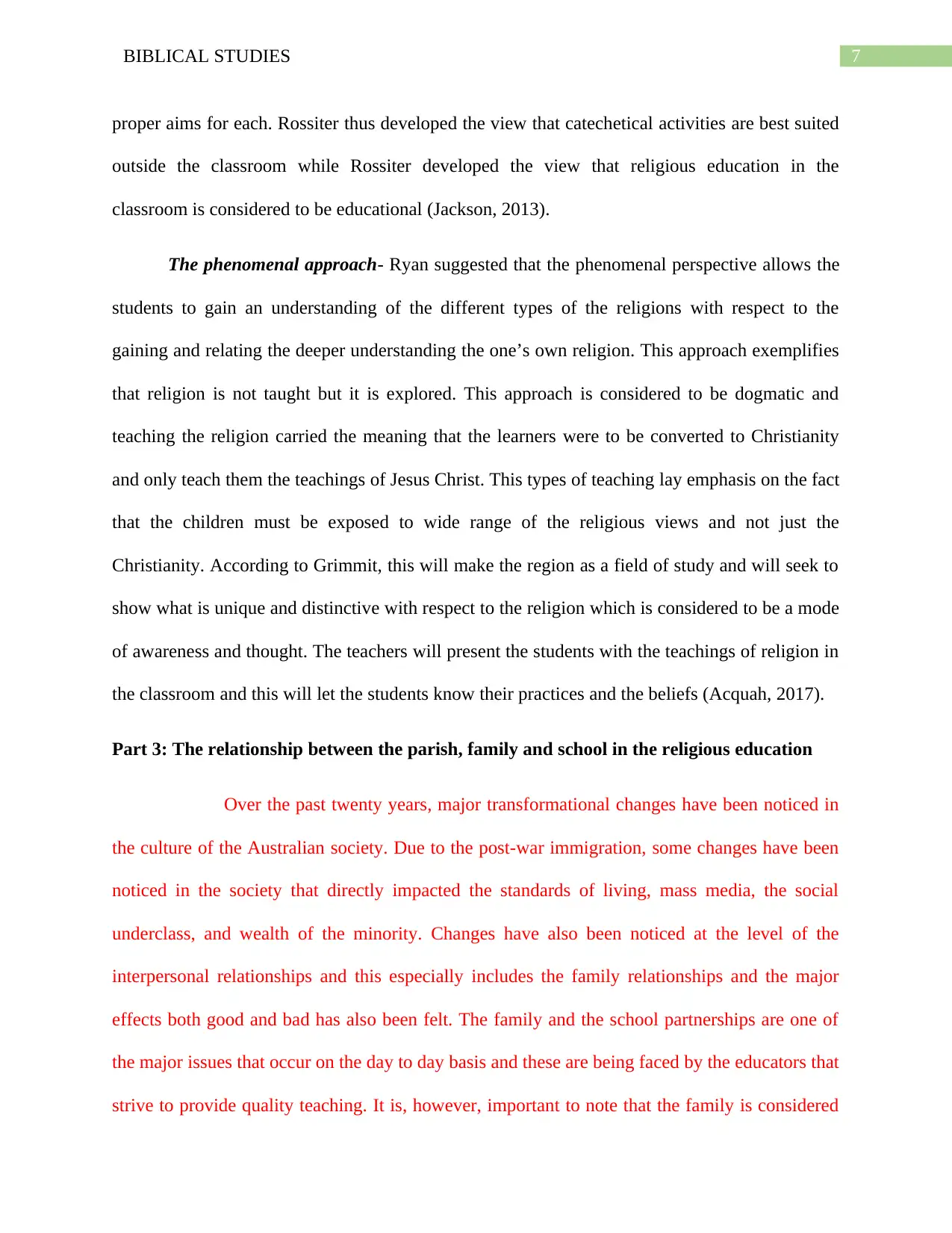
7BIBLICAL STUDIES
proper aims for each. Rossiter thus developed the view that catechetical activities are best suited
outside the classroom while Rossiter developed the view that religious education in the
classroom is considered to be educational (Jackson, 2013).
The phenomenal approach- Ryan suggested that the phenomenal perspective allows the
students to gain an understanding of the different types of the religions with respect to the
gaining and relating the deeper understanding the one’s own religion. This approach exemplifies
that religion is not taught but it is explored. This approach is considered to be dogmatic and
teaching the religion carried the meaning that the learners were to be converted to Christianity
and only teach them the teachings of Jesus Christ. This types of teaching lay emphasis on the fact
that the children must be exposed to wide range of the religious views and not just the
Christianity. According to Grimmit, this will make the region as a field of study and will seek to
show what is unique and distinctive with respect to the religion which is considered to be a mode
of awareness and thought. The teachers will present the students with the teachings of religion in
the classroom and this will let the students know their practices and the beliefs (Acquah, 2017).
Part 3: The relationship between the parish, family and school in the religious education
Over the past twenty years, major transformational changes have been noticed in
the culture of the Australian society. Due to the post-war immigration, some changes have been
noticed in the society that directly impacted the standards of living, mass media, the social
underclass, and wealth of the minority. Changes have also been noticed at the level of the
interpersonal relationships and this especially includes the family relationships and the major
effects both good and bad has also been felt. The family and the school partnerships are one of
the major issues that occur on the day to day basis and these are being faced by the educators that
strive to provide quality teaching. It is, however, important to note that the family is considered
proper aims for each. Rossiter thus developed the view that catechetical activities are best suited
outside the classroom while Rossiter developed the view that religious education in the
classroom is considered to be educational (Jackson, 2013).
The phenomenal approach- Ryan suggested that the phenomenal perspective allows the
students to gain an understanding of the different types of the religions with respect to the
gaining and relating the deeper understanding the one’s own religion. This approach exemplifies
that religion is not taught but it is explored. This approach is considered to be dogmatic and
teaching the religion carried the meaning that the learners were to be converted to Christianity
and only teach them the teachings of Jesus Christ. This types of teaching lay emphasis on the fact
that the children must be exposed to wide range of the religious views and not just the
Christianity. According to Grimmit, this will make the region as a field of study and will seek to
show what is unique and distinctive with respect to the religion which is considered to be a mode
of awareness and thought. The teachers will present the students with the teachings of religion in
the classroom and this will let the students know their practices and the beliefs (Acquah, 2017).
Part 3: The relationship between the parish, family and school in the religious education
Over the past twenty years, major transformational changes have been noticed in
the culture of the Australian society. Due to the post-war immigration, some changes have been
noticed in the society that directly impacted the standards of living, mass media, the social
underclass, and wealth of the minority. Changes have also been noticed at the level of the
interpersonal relationships and this especially includes the family relationships and the major
effects both good and bad has also been felt. The family and the school partnerships are one of
the major issues that occur on the day to day basis and these are being faced by the educators that
strive to provide quality teaching. It is, however, important to note that the family is considered
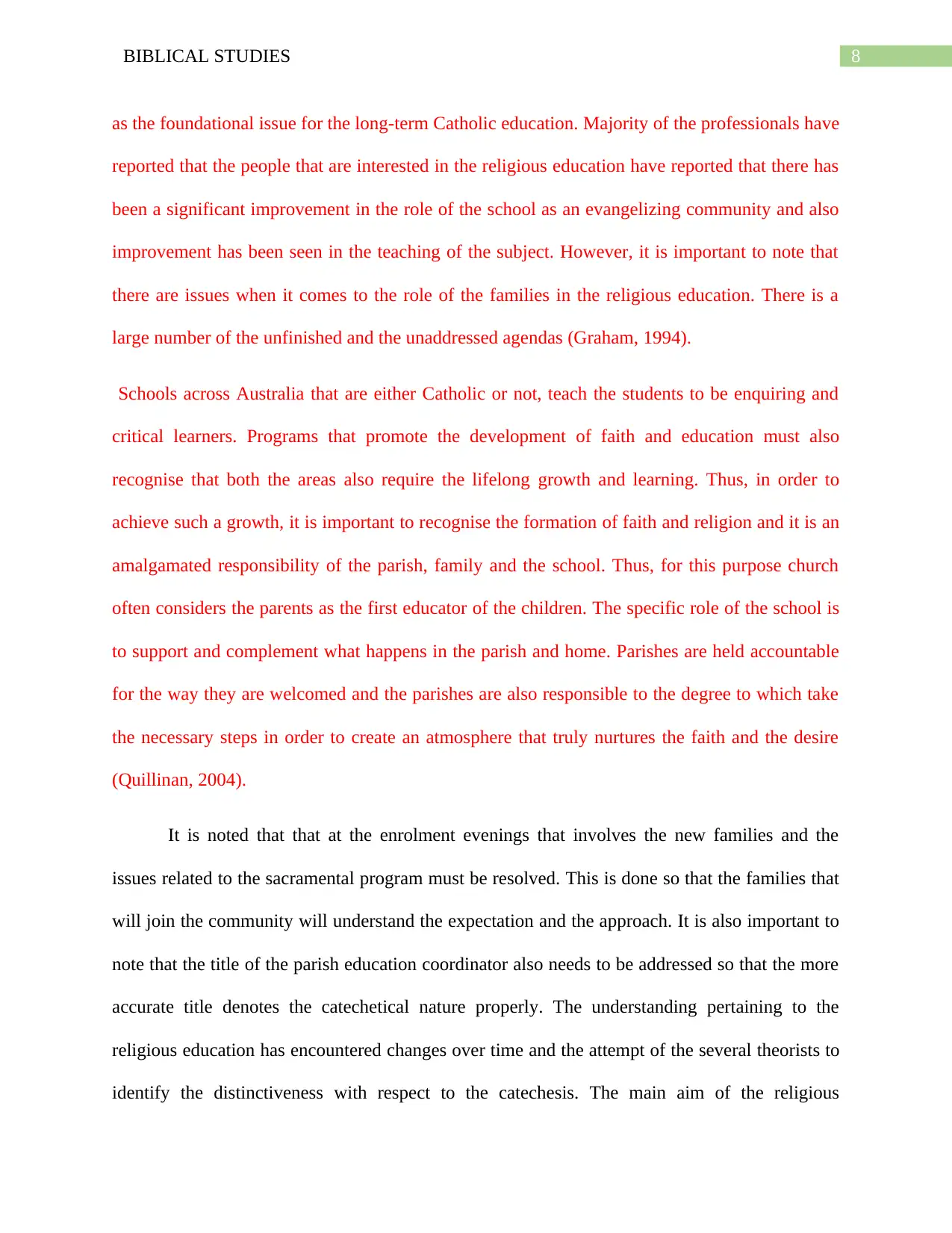
8BIBLICAL STUDIES
as the foundational issue for the long-term Catholic education. Majority of the professionals have
reported that the people that are interested in the religious education have reported that there has
been a significant improvement in the role of the school as an evangelizing community and also
improvement has been seen in the teaching of the subject. However, it is important to note that
there are issues when it comes to the role of the families in the religious education. There is a
large number of the unfinished and the unaddressed agendas (Graham, 1994).
Schools across Australia that are either Catholic or not, teach the students to be enquiring and
critical learners. Programs that promote the development of faith and education must also
recognise that both the areas also require the lifelong growth and learning. Thus, in order to
achieve such a growth, it is important to recognise the formation of faith and religion and it is an
amalgamated responsibility of the parish, family and the school. Thus, for this purpose church
often considers the parents as the first educator of the children. The specific role of the school is
to support and complement what happens in the parish and home. Parishes are held accountable
for the way they are welcomed and the parishes are also responsible to the degree to which take
the necessary steps in order to create an atmosphere that truly nurtures the faith and the desire
(Quillinan, 2004).
It is noted that that at the enrolment evenings that involves the new families and the
issues related to the sacramental program must be resolved. This is done so that the families that
will join the community will understand the expectation and the approach. It is also important to
note that the title of the parish education coordinator also needs to be addressed so that the more
accurate title denotes the catechetical nature properly. The understanding pertaining to the
religious education has encountered changes over time and the attempt of the several theorists to
identify the distinctiveness with respect to the catechesis. The main aim of the religious
as the foundational issue for the long-term Catholic education. Majority of the professionals have
reported that the people that are interested in the religious education have reported that there has
been a significant improvement in the role of the school as an evangelizing community and also
improvement has been seen in the teaching of the subject. However, it is important to note that
there are issues when it comes to the role of the families in the religious education. There is a
large number of the unfinished and the unaddressed agendas (Graham, 1994).
Schools across Australia that are either Catholic or not, teach the students to be enquiring and
critical learners. Programs that promote the development of faith and education must also
recognise that both the areas also require the lifelong growth and learning. Thus, in order to
achieve such a growth, it is important to recognise the formation of faith and religion and it is an
amalgamated responsibility of the parish, family and the school. Thus, for this purpose church
often considers the parents as the first educator of the children. The specific role of the school is
to support and complement what happens in the parish and home. Parishes are held accountable
for the way they are welcomed and the parishes are also responsible to the degree to which take
the necessary steps in order to create an atmosphere that truly nurtures the faith and the desire
(Quillinan, 2004).
It is noted that that at the enrolment evenings that involves the new families and the
issues related to the sacramental program must be resolved. This is done so that the families that
will join the community will understand the expectation and the approach. It is also important to
note that the title of the parish education coordinator also needs to be addressed so that the more
accurate title denotes the catechetical nature properly. The understanding pertaining to the
religious education has encountered changes over time and the attempt of the several theorists to
identify the distinctiveness with respect to the catechesis. The main aim of the religious
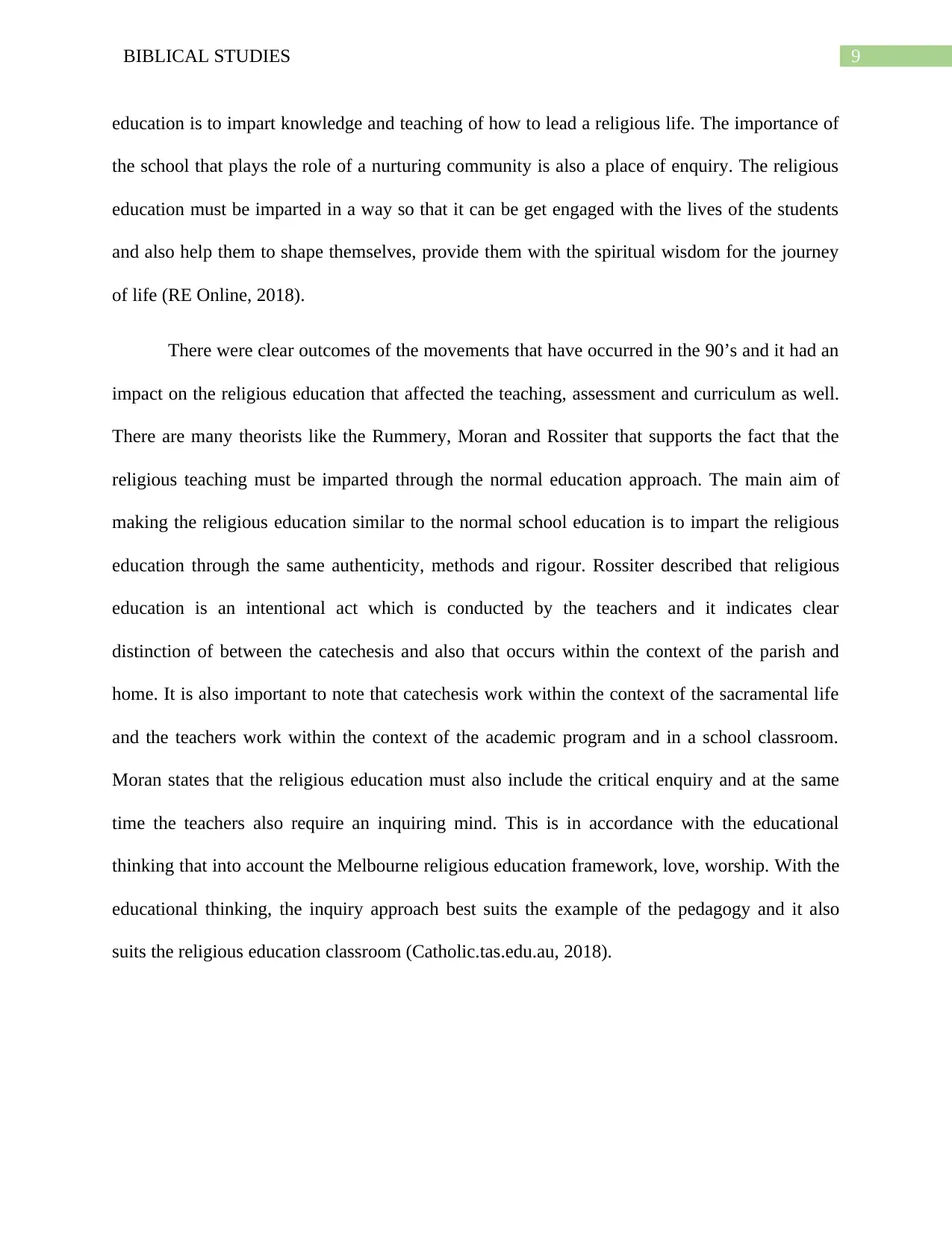
9BIBLICAL STUDIES
education is to impart knowledge and teaching of how to lead a religious life. The importance of
the school that plays the role of a nurturing community is also a place of enquiry. The religious
education must be imparted in a way so that it can be get engaged with the lives of the students
and also help them to shape themselves, provide them with the spiritual wisdom for the journey
of life (RE Online, 2018).
There were clear outcomes of the movements that have occurred in the 90’s and it had an
impact on the religious education that affected the teaching, assessment and curriculum as well.
There are many theorists like the Rummery, Moran and Rossiter that supports the fact that the
religious teaching must be imparted through the normal education approach. The main aim of
making the religious education similar to the normal school education is to impart the religious
education through the same authenticity, methods and rigour. Rossiter described that religious
education is an intentional act which is conducted by the teachers and it indicates clear
distinction of between the catechesis and also that occurs within the context of the parish and
home. It is also important to note that catechesis work within the context of the sacramental life
and the teachers work within the context of the academic program and in a school classroom.
Moran states that the religious education must also include the critical enquiry and at the same
time the teachers also require an inquiring mind. This is in accordance with the educational
thinking that into account the Melbourne religious education framework, love, worship. With the
educational thinking, the inquiry approach best suits the example of the pedagogy and it also
suits the religious education classroom (Catholic.tas.edu.au, 2018).
education is to impart knowledge and teaching of how to lead a religious life. The importance of
the school that plays the role of a nurturing community is also a place of enquiry. The religious
education must be imparted in a way so that it can be get engaged with the lives of the students
and also help them to shape themselves, provide them with the spiritual wisdom for the journey
of life (RE Online, 2018).
There were clear outcomes of the movements that have occurred in the 90’s and it had an
impact on the religious education that affected the teaching, assessment and curriculum as well.
There are many theorists like the Rummery, Moran and Rossiter that supports the fact that the
religious teaching must be imparted through the normal education approach. The main aim of
making the religious education similar to the normal school education is to impart the religious
education through the same authenticity, methods and rigour. Rossiter described that religious
education is an intentional act which is conducted by the teachers and it indicates clear
distinction of between the catechesis and also that occurs within the context of the parish and
home. It is also important to note that catechesis work within the context of the sacramental life
and the teachers work within the context of the academic program and in a school classroom.
Moran states that the religious education must also include the critical enquiry and at the same
time the teachers also require an inquiring mind. This is in accordance with the educational
thinking that into account the Melbourne religious education framework, love, worship. With the
educational thinking, the inquiry approach best suits the example of the pedagogy and it also
suits the religious education classroom (Catholic.tas.edu.au, 2018).
Secure Best Marks with AI Grader
Need help grading? Try our AI Grader for instant feedback on your assignments.
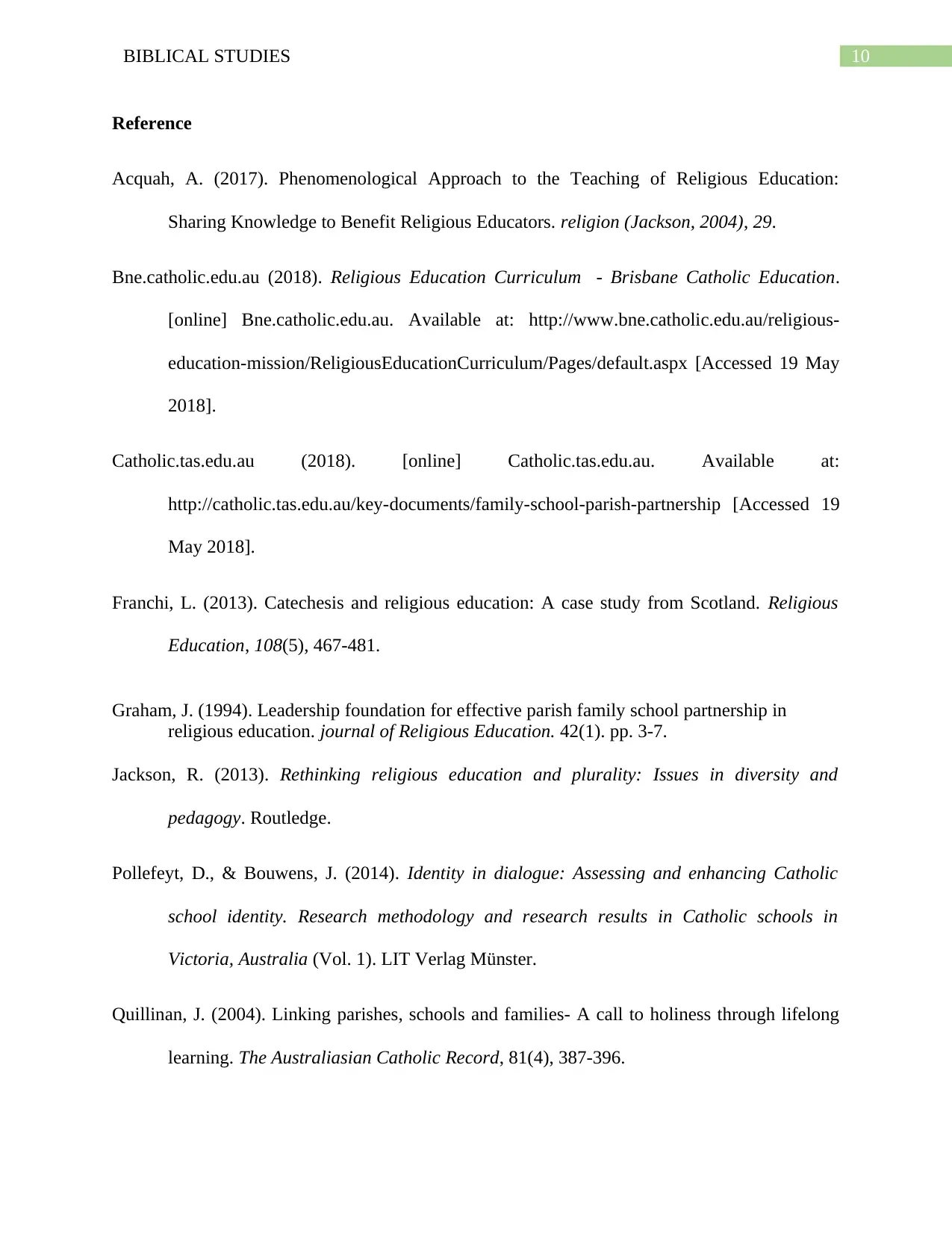
10BIBLICAL STUDIES
Reference
Acquah, A. (2017). Phenomenological Approach to the Teaching of Religious Education:
Sharing Knowledge to Benefit Religious Educators. religion (Jackson, 2004), 29.
Bne.catholic.edu.au (2018). Religious Education Curriculum - Brisbane Catholic Education.
[online] Bne.catholic.edu.au. Available at: http://www.bne.catholic.edu.au/religious-
education-mission/ReligiousEducationCurriculum/Pages/default.aspx [Accessed 19 May
2018].
Catholic.tas.edu.au (2018). [online] Catholic.tas.edu.au. Available at:
http://catholic.tas.edu.au/key-documents/family-school-parish-partnership [Accessed 19
May 2018].
Franchi, L. (2013). Catechesis and religious education: A case study from Scotland. Religious
Education, 108(5), 467-481.
Graham, J. (1994). Leadership foundation for effective parish family school partnership in
religious education. journal of Religious Education. 42(1). pp. 3-7.
Jackson, R. (2013). Rethinking religious education and plurality: Issues in diversity and
pedagogy. Routledge.
Pollefeyt, D., & Bouwens, J. (2014). Identity in dialogue: Assessing and enhancing Catholic
school identity. Research methodology and research results in Catholic schools in
Victoria, Australia (Vol. 1). LIT Verlag Münster.
Quillinan, J. (2004). Linking parishes, schools and families- A call to holiness through lifelong
learning. The Australiasian Catholic Record, 81(4), 387-396.
Reference
Acquah, A. (2017). Phenomenological Approach to the Teaching of Religious Education:
Sharing Knowledge to Benefit Religious Educators. religion (Jackson, 2004), 29.
Bne.catholic.edu.au (2018). Religious Education Curriculum - Brisbane Catholic Education.
[online] Bne.catholic.edu.au. Available at: http://www.bne.catholic.edu.au/religious-
education-mission/ReligiousEducationCurriculum/Pages/default.aspx [Accessed 19 May
2018].
Catholic.tas.edu.au (2018). [online] Catholic.tas.edu.au. Available at:
http://catholic.tas.edu.au/key-documents/family-school-parish-partnership [Accessed 19
May 2018].
Franchi, L. (2013). Catechesis and religious education: A case study from Scotland. Religious
Education, 108(5), 467-481.
Graham, J. (1994). Leadership foundation for effective parish family school partnership in
religious education. journal of Religious Education. 42(1). pp. 3-7.
Jackson, R. (2013). Rethinking religious education and plurality: Issues in diversity and
pedagogy. Routledge.
Pollefeyt, D., & Bouwens, J. (2014). Identity in dialogue: Assessing and enhancing Catholic
school identity. Research methodology and research results in Catholic schools in
Victoria, Australia (Vol. 1). LIT Verlag Münster.
Quillinan, J. (2004). Linking parishes, schools and families- A call to holiness through lifelong
learning. The Australiasian Catholic Record, 81(4), 387-396.
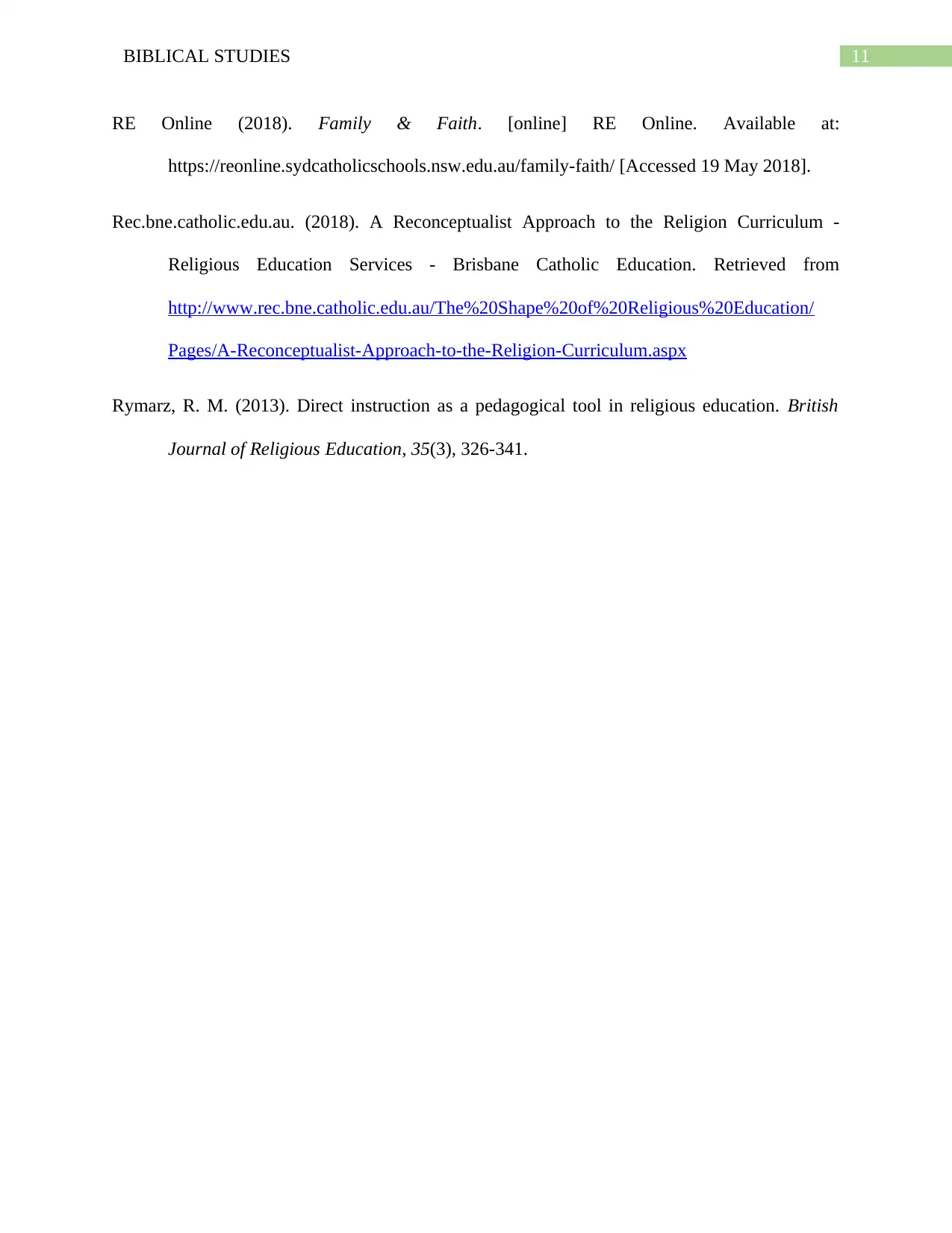
11BIBLICAL STUDIES
RE Online (2018). Family & Faith. [online] RE Online. Available at:
https://reonline.sydcatholicschools.nsw.edu.au/family-faith/ [Accessed 19 May 2018].
Rec.bne.catholic.edu.au. (2018). A Reconceptualist Approach to the Religion Curriculum -
Religious Education Services - Brisbane Catholic Education. Retrieved from
http://www.rec.bne.catholic.edu.au/The%20Shape%20of%20Religious%20Education/
Pages/A-Reconceptualist-Approach-to-the-Religion-Curriculum.aspx
Rymarz, R. M. (2013). Direct instruction as a pedagogical tool in religious education. British
Journal of Religious Education, 35(3), 326-341.
RE Online (2018). Family & Faith. [online] RE Online. Available at:
https://reonline.sydcatholicschools.nsw.edu.au/family-faith/ [Accessed 19 May 2018].
Rec.bne.catholic.edu.au. (2018). A Reconceptualist Approach to the Religion Curriculum -
Religious Education Services - Brisbane Catholic Education. Retrieved from
http://www.rec.bne.catholic.edu.au/The%20Shape%20of%20Religious%20Education/
Pages/A-Reconceptualist-Approach-to-the-Religion-Curriculum.aspx
Rymarz, R. M. (2013). Direct instruction as a pedagogical tool in religious education. British
Journal of Religious Education, 35(3), 326-341.
1 out of 12
Your All-in-One AI-Powered Toolkit for Academic Success.
+13062052269
info@desklib.com
Available 24*7 on WhatsApp / Email
![[object Object]](/_next/static/media/star-bottom.7253800d.svg)
Unlock your academic potential
© 2024 | Zucol Services PVT LTD | All rights reserved.
